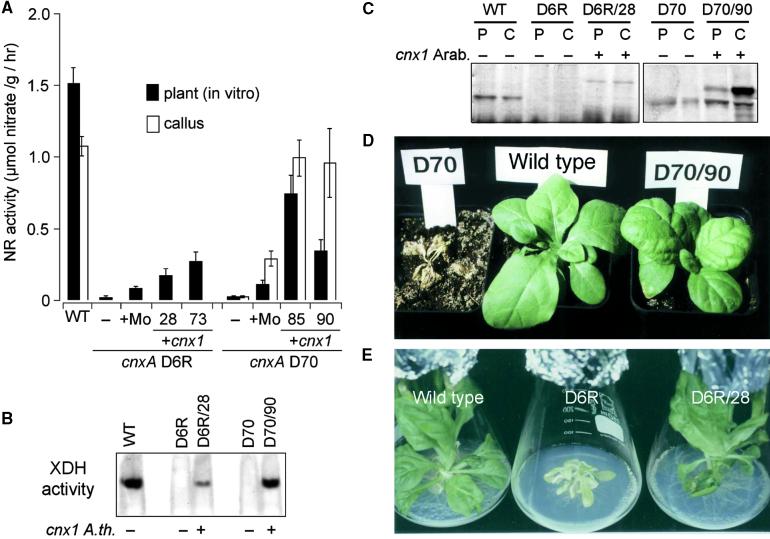Figure 6.
Functional Complementation of Moco Biosynthesis in N. plumbaginifolia cnxA Mutants by Heterologous Expression of Arabidopsis cnx1 cDNA.
(A) NR activity of the wild-type (WT) and cnxA mutant plants (WT, D6R and D70; black bars) and callus cultures (WT and D70 [line D6R was not determined]; white bars). The mutants were either untransformed (−) or grown in the presence of 1 mM sodium molybdate in the growth media (+Mo) or transformed with Arabidopsis cnx1 cDNA (+cnx1). Two representative clones of transformed D6 (D6R/28 and D6R/73) and D70 (D70/85 and D70/90) were analyzed. Before harvesting, all plants and callus cultures were grown for 6 days on nitrate-containing media. The bars represent mean values of three to eight independent measurements with the standard errors shown.
(B) Xanthine dehydrogenase activity (XDH) of wild-type (WT, −) and mutant lines cnxA D6R (−) and D70 (−) as well as D6R and D70 complemented (+) with the Arabidopsis cnx1 cDNA (D6R/28 and D70/90). Crude protein extracts of callus cultures (25 μg per lane) were separated in a 5% discontinuous native gel electrophoresis system and stained for in situ enzyme activity according to Mendel and Müller (1976).
(C) Protein gel blot analysis of crude protein extracts shown in (B) that were derived from plants (P) and callus cultures (C). The same amounts of total protein (50 μg) were loaded onto a 7.5% SDS–polyacrylamide gel, blotted onto a polyvinylpolypyrrolidone membrane, and detected by using polyclonal Cnx1 antibodies (Ak90cnx1; 1:2000 dilution). Samples transformed with cnx1 are indicated (+).
(D) and (E) Normalization of the mutant phenotype. In (D), all plants shown were grown in sterile culture and transferred on the same day into soil fertilized with potassium nitrate as the nitrogen source. At left is the Moco-deficient cnxA mutant D70; it is unable to grow in soil and dies. At center is the wild-type N. plumbaginifolia. At right is the D70 transformant (D70/90) expressing Arabidopsis Cnx1. The wild-type–like phenotype of the D70/90 plant is representative of 21 cnx1-transformed and regenerated mutant plants. (E) In vitro culture of the wild-type N. plumbaginifolia (left), the cnxA D6R plant with small, crinkled leaves (middle), and a representative D6R transformant (D6R/28) expressing Arabidopsis Cnx1 (right).

